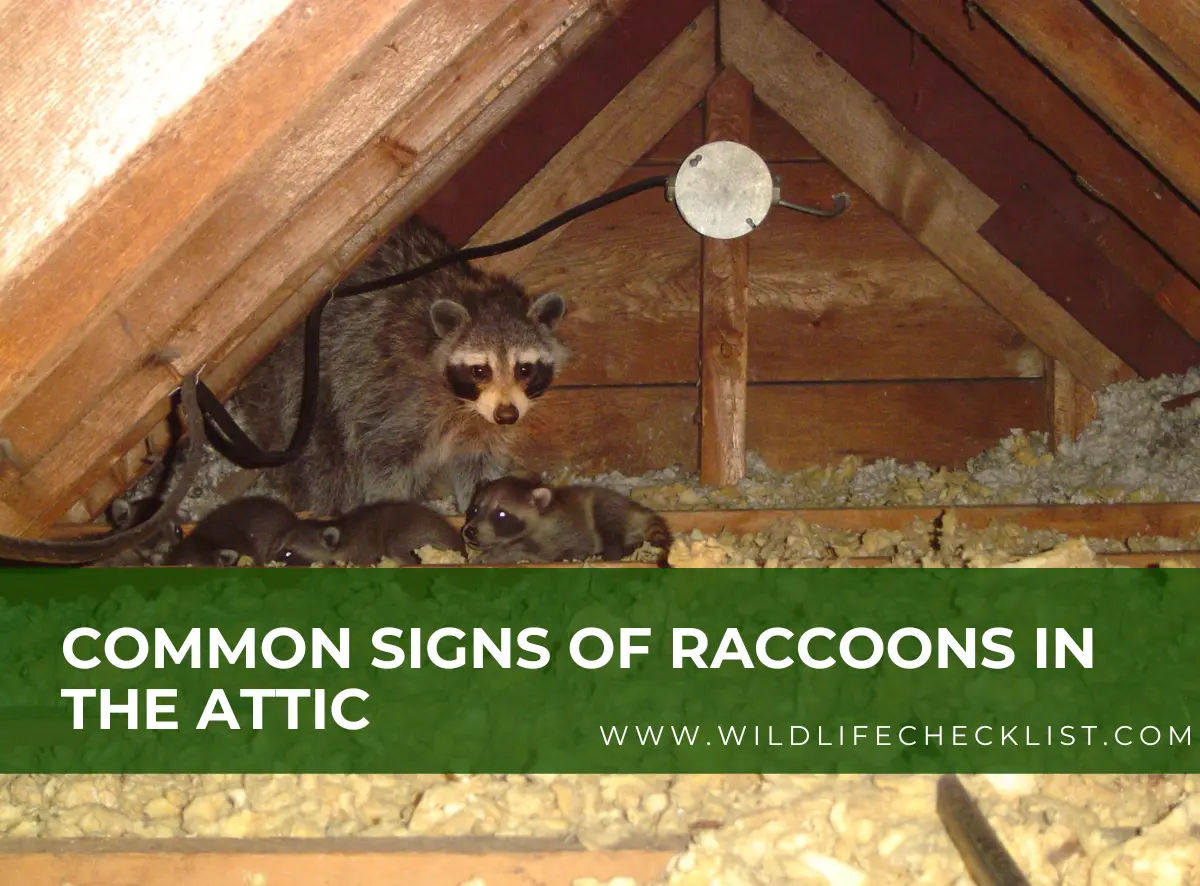7 Common Signs Of Raccoons In The Attic And How To Prevent Them

The presence of an animal in a place is always felt by some signs from the animal. Raccoons that are know as intelligent animals have signs they show to signify their presence. So, in this article we will be checking some of the signs of raccoons in attic.
Whether you’re dealing with raccoon roomies or just curious about what to watch out for, buckle up as we guide you through the signs of raccoons in the attic and empower you to take the right steps to handle this critter conundrum.
Contents
Why Raccoons in the Attic a Concern
Raccoons in the attic might sound like an interesting wildlife encounter, but trust me, it’s not a situation you want to shrug off. Here’s why having these troublemakers animal as houseguests can quickly turn into a real headache:
1. Property Damage
Raccoons are natural-born climbers and curious travellers. Unfortunately, your attic isn’t a raccoon playground; they don’t play nicely with your insulation, wires, and structural components. Expect chewed-up wires, torn insulation, and possibly pricey repairs.
2. Health Risks
Raccoon droppings aren’t just gross; they can carry dangerous pathogens, including raccoon roundworm. Breathing in these particles or coming into contact with them presents a risk to you, your family, and even your pets.
3. Noise Disturbances
Raccoons are busy mainly during the night, which means you’ll be treated to a nightly symphony of thumps, bumps, and chittering. Your peaceful sleep takes a hit, leading to afternoon fatigue and frustration.
4. Mess and Odor
Raccoon homes aren’t exactly known for their tidiness. They can make quite a mess in your attic, leaving droppings, torn insulation, and general chaos behind. This also means potential odors seeping into your living area.
5. Legal and Humane Concerns
Evicting raccoons isn’t as easy as shooing them away. Many places have strict rules about trapping and relocating wildlife. Mishandling the situation can land you in legal trouble, and it’s important to address the issue humanely.
In a nutshell, raccoons in the attic aren’t just a quirky encounter with nature; they’re a genuine worry for your property, health, sleep, and even legal standing. Suppose you think these masked bandits have set up camp in your attic. In that case, it’s crucial to tackle the situation promptly, safely, and in compliance with local laws.
Common Signs of Raccoons in the Attic
So, you’ve got an attic, and you’ve heard raccoons might be hanging out there. You’re not alone – raccoons love the cozy, sheltered condition attics provide. But how do you know if you’ve got these masked robbers as uninvited guests? Here are the usual signs to watch out for:
1. Unexplained Noises
Do you find yourself wondering if you’ve got a tiny bowling alley or a raccoon dance party going above your head at night? Raccoons are most busy during the evening and early morning hours and are not exactly quiet about it. Listen for banging, scratching, and chattering sounds.
2. Poop
Nobody likes talking about this, but raccoon droppings clearly show their presence. These little piles resemble small dog droppings, but they have a unique texture and a noticeable smell. If you spot these in your attic, it clearly indicates raccoon activity.
3. Insulation Havoc
Raccoons are master nest makers, and your insulation is like their version of a plush hotel bed. Consider it a raccoon’s signature move if you notice torn insulation or even insulation chunks spread around. It’s all part of their quest for a cozy house.
4. Chewed Wires
These critters are not just about soft bedding; they also have a curious streak. Chewed wires are a regular outcome of their exploration. This isn’t just a minor annoyance; it can be a major fire hazard. So, if you find wires with nibble marks, you’ve got more than just a raccoon problem – a possible disaster is waiting to happen.
5. Claw Marks and Grease Stains
Raccoons are great climbers, and they tend to leave traces behind. Look for claw marks near possible entry places, such as vents. These marks might not be glaringly visible, but they’re evidence of raccoon activity. Grease stains around entry points are also a giveaway, caused by the oils in their fur as they squeeze in.
6. Entry Points
Raccoons don’t suddenly teleport into your attic; they need a door, so to speak. Check for any possible entry points. Loose vents or holes in the roof are all appealing to raccoons. These animals are clever, and they’ll find weak spots you might not even notice.
7. Odor and Urine Marks
Raccoons have a unique musky smell. Suppose you suddenly start detecting an unusual, strong odor in your home, especially concentrated around the attic. In that case, it’s a significant sign that raccoons might be using it as a bathroom, among other things. Raccoon urine has a distinctive scent, and it’s not something you want lingering in your living area.
Prevention and Removal Methods
Preventing and removing raccoons from your attic isn’t just a matter of convenience; it’s about protecting your home and ensuring a safe environment for your family. Here’s what you need to know:
Prevention
1. Seal Entry Points
Conduct a thorough check to identify potential entry points, like loose vents, damaged screens, or gaps in the roof. Seal these holes with sturdy materials to keep raccoons out.
2. Trim Trees and Vegetation
Raccoons are agile climbers. Trim tree branches and plants that might provide easy access to your roof.
3. Secure Trash Bins
Raccoons are drawn to food sources. Ensure your trash bins have secure lids to keep these scavengers off your property.
4. Regular Inspections
Keep an eye on your attic. Regularly check for any signs of raccoon activity, like droppings, claw marks, or strange noises.
Removal
1. Professional Help
If you think raccoons have already moved in, it’s best to call a wildlife removal expert. They know the local laws and have the expertise to safely and humanely evict raccoons.
2. Humane Trapping
If DIY removal is allowed in your area, use gentle live traps. Once caught, release the raccoon far away from your home in a suitable habitat.
3. Clean Up
After removal, clean and disinfect your attic to remove any lingering odors, parasites, or potential health hazards left behind.
Remember, timely action is important. Ignoring raccoon issues can lead to expensive property damage and health risks. Stay vigilant, take preventative steps, and address the situation responsibly.
Why Do Raccoons Like Attics?
Raccoons have a knack for cozy hideouts, and your attic is their idea of a five-star getaway! Here’s why they’re so into attics:
1. Safe Haven
Attics provide shelter from the elements and possible predators. It’s like a raccoon fortress, far away from the noise and bustle.
2. Warmth and Comfort
Attics are snug and warm, making them perfect for raccoons wanting a comfy nesting spot, especially during colder months.
3. Peace and Quiet
Human activity is minimal in attics, giving raccoons a serene setting for their daily naps and socializing.
4. Storage Galore
Raccoons are interesting critters. Attics filled with boxes and old stuff are like a raccoon playground, perfect for exploring and building nests.
5. Easy Access
Raccoons are great climbers. Trees and nearby buildings make accessing attics a cinch for them.
So, if you find raccoons have taken a liking to your attic, it’s not personal. They’re just drawn to the comfort and convenience it gives. Time to show them the eviction letter and make your attic human-only once again!
Can I handle Raccoon Removal on my Own?
While it’s possible to handle raccoon removal on your own, it’s not suggested. Raccoons can be unpredictable, and DIY removal offers risks. Additionally, many places have rules on trapping and relocating wildlife.
Professional wildlife removal experts have the knowledge, experience, and tools to ensure safe, humane, and legal removal while minimizing the potential for harm to you, the raccoons, and your property. It’s best to leave raccoon removal to the pros to avoid potential complications and ensure a successful, responsible outcome.
Conclusion
To wrap it up, being aware of the signs of raccoons in your attic is important for keeping the comfort and safety of your home. By recognizing these clues early, you can take proactive steps to avoid potential damage and health risks.
Remember, it’s not just about evicting raccoons; it’s about ensuring a harmonious living place for you and your family. From the strange sounds to the telltale droppings, you now have the tools to discover these uninvited guests.
So, keep your ears tuned, check your space regularly, and stay informed on humane removal methods. With this information, you’re prepared to protect your home and say goodbye to raccoons in the attic, ensuring that your sanctuary remains truly yours.




